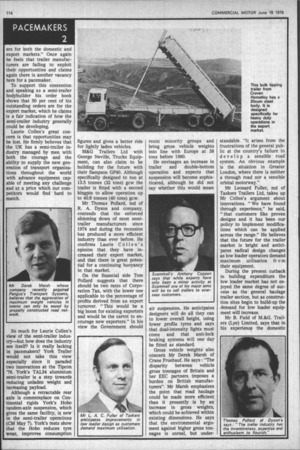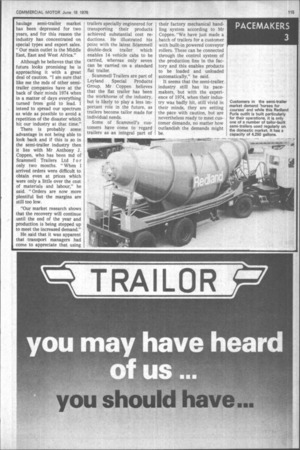Every industry needs a pacemaker and in the semi-trailer industry the pacemaker keeps changing...
Page 115

Page 116

Page 117

If you've noticed an error in this article please click here to report it so we can fix it.
According to Mr Laurie Cohen of Cohen (Transport Designs) Ltd of Gillingham, Kent, the industry is ready for a new pacemaker now. He says none of the semi-trailers made in the UK or cross-channel Europe are designed for the Middle East markets or even the Far East markets, that are to come.
Laurie Colien's qualifications for speaking are 25 years in the semi-trailer industry with Merriworth Trailers, Boden Trailers and Crane Fruehauf. Now as a bodybuilder he believes he can speak not only with knowledge but without bias.
His real interest in semitrailer and body design has always been on TIR work—he introduced the transverse roof gate which replaced the traditional timber-board design, which he claims resulted in a high incidence of driver injury and excessive maintenance costs. He is now looking at a side superstructure which will withstand the strains of un ers timorous but few manufacturers will be brave enough to take the first step, he believes.
Looking at the trend in TIR traffic he thinks that for the Continent at least there will need to be an extension of the German and French road/rail systems. "There will be an increasing amount of traffic moving in and through Europe in the next few years," he said, "and if we measure the amount of traffic which has been travelling during the current depression we can get some idea how much it will escalate when times are less difficult."
With pressure from governments, environmentalists and conservationalists, Mr Cohen feels that transporting complete artic outfits over the entire length of Europe by rail will become a legal requirement.
made roads in underdeveloped countries.
As he sees the future of the industry, semi-trailers will have to be developed which will be able to stand excessively long journeys, in extremes of temperature and over terrain with poor road surfaces or where there are no roads at all. The first move he thinks should be fitting air suspension as standard because of its ability to dramatically reduce vibration fatigue " The additional cost of around £700 may seem high," he says, " but when compared with the cost of repairing trailers thousands of miles from home it will prove well worthwhile."
Vacancy
According to Mr Cohen it is unavoidable that the unladen weight of semi-trailer chassis will increase with the demand for more robust vehicles. He estimates that the unladen weight of a tandem-axle trailer could rise by as much as 1 ton. This could be a pacemaker vacancy which might prove difficult to fill since an increase in unladen weight imposes a penalty on the payload.
This not only makes custom
Men of courage
He points out that this means the development of semi-trailers suitable for road/ rail operation with suitably constructed TIR tilts. Once again a pacemaker will be required.
While we hear of spare trailer capacity at the moment it appears that as industry and exports pick away there will be insufficient supply to meet demand. Already the signs are that industry is on the move and from a situation where trailers were available off-theshelf last year, according to Laurie Cohen there is now a threeto four-month delivery delay. He sees this as an unfortunate state of affairs with such a vast export market sitting on our doorstep. He claims that the UK is the bargainbasement of Europe for trailer purchasers.
"Our products are about half the price of our European competitors and this is the time when we should be investing to produce more trail ers for both the domestic and export markets." Once again he feels that trailer manufacturers are failing to exploit their opportunities and claims again there is another vacancy here for a pacemaker.
TO support this contention and speaking as a semi-trailer bodybuilder his order book shows that 50 per cent of his outstanding orders are for the export market, which he claims is a fair indication of how the semi-trailer industry generally could be developing.
Laurie Colien's great concern is that opportunities may be lost. He firmly believes that the UK has a semi-trailer industry managed by men with both the courage and the ability to supply the new generation of transport organisations throughout the world with advance equipment capable of meeting any challenge and at a price which our competitors would find hard to match.
So much for Laurie Colien's view of the semi-trailer industry—but how does the industry see itself? Is it really lacking in pacemakers? York Trailer would not take this view especially since it paraded two innovations at the Tipcon '76. York's TAL34 aluminium semi-trailer is a step towards reducing unladen weight and increasing payload.
Although a retractable rear axle is commonplace on Continental rigids York's Hobo tandem-axle suspension, which gives the same facility, is new in the semi-trailer operations (CM May 7). York's tests show that the Hobo reduces tyre wear, improves consumption figures and gives a better ride for lightly laden vehicles.
M&G Trailers Ltd with George Neville, Trucks Equipment, can also claim to be building for the future with their Sampson GP40. Although specifically designed to run at 13.5 tonnes (32 tons) gcw the trailer is fitted with a second kingpin to allow operation up to 40.6 tonnes (40 tons) gcw.
Mr Thomas Pollard, md of R. A. Dyson and company, contends that the enforced slimming down of most semitrailer manufacturers since 1974 and during the recession has produced a more efficient industry than ever before. He confirms Laurie C o 11 en's opinion that they have increased their export market, and that there is great potential for a continuing buoyancy in that market.
On the financial side Tom Pollard suggests that there should be two rates of Corporation Tax, with the lower one applicable to the percentage of profits derived from an export turnover. "This would be a big boost for existing exporters and would be the carrot to encourage new exporters." In his view the Government should resist minority groups and bring gross vehicle weights into line with Europe at 38 tons before 1980.
He envisages an increase in trailer and double-bottom operation and expects that suspension will become sophisticated, although he did not say whether this would mean air suspension. He anticipates designers will do all they can to lower overall height, using lower profile tyres and says that dual-intensity lights must come and that anti-lock braking systems will one day be fitted as standard.
Gross vehicle weights also concern Mr Derek Marsh of Crane Fruehauf. He says : "The disparity between vehicle gross tonnages of Britain and her EEC partners imposes a burden on British manufacturers". Mr Marsh emphasises the point that road haulage could be made more efficient than it presently is by an increase in gross weights, which could be achieved within existing dimensions. He says that the environmental argument against higher gross tonnages is unreal, but under standable. "It arises from the frustrations of the general public at the country's failure to develop a sensible road system. An obvious example is the situation in Greater London, where there is neither a through road nor a sensible orbital motorway."
Mr Leonard Fuller, md of Taskers Trailers Ltd, takes up Mr Colien's argument about innovations. "We have found through experience," he said, "that customers like proven designs and it has been our policy to implement modifications which can be applied across the range." He believes that the future for the trailer market is bright and anticipates radical design changes as low loader operators demand maximum utilisation fr o m their equipment.
During the present cutback in building expenditure the low loader market has not enjoyed the same degree of success as the general haulage trailer section, but as construction sites begin to build-up the demand for low loader equipment will increase.
Mr B. Field of M.8EG. Trailers (Lye) Limited, says that in his experience the domestic haulage semi-trailer market has been depressed for two years, and for this reason the industry has concentrated on special types and export sales. "Our main outlet is the Middle East, East and West Africa."
Although he believes that the future looks promising he is approaching it with a great deal of caution. "I am sure that like me the mds of other semitrailer companies have at the back of their minds 1974 when in a matter of days everything turned from gold to lead. I intend to spread our spectrum as wide as possible to avoid a repetition of the disaster which hit our industry at that time."
There is probably some advantage in not being able to look back and if this is so in the semi-trailer industry then it lies with Mr Anthony J. Coppen, who has been md of Scammell Trailers Ltd f o r only two months. "When I arrived orders were difficult to obtain even at prices which were only a little over the cost of materials and labour," he said. "Orders are now more plentiful but the margins are still too low.
"Our market research shows that the recovery will continue until the end of the year and production is being stepped up to meet the increased demand."
He said that it was apparent that transport managers had come to appreciate that using trailers specially engineered for transporting their products achieved substantial cost reductions. He illustrated his point with the latest Scammell double-deck trailer which enables 14 vehicle cabs to be carried, whereas only seven can be carried on a standard flat trailer.
Scammell Trailers are part of Leyland Special Products Group. Mr Coppen believes that the flat trailer has been the workhorse of the industry, but is likely to play a less important role in the future, as trailers become tailor made for individual needs.
Some of Scammell's customers have come to regard trailers as an integral part of their factory mechanical handling system according to Mr Coppen."We have just made a batch of trailers for a customer with built-in powered conveyor rollers. These can be connected through the control system of the production line in the factory and this enables products to be loaded and unloaded automatically," he said.
It seems that the semi-trailer industry still has its pacemakers, but with the experience of 1974, when their industry was badly hit, still vivid in their minds, they are setting the pace with caution, but are nevertheless ready to meet customer demands, no matter how outlandish the demands might be.












































































































































































